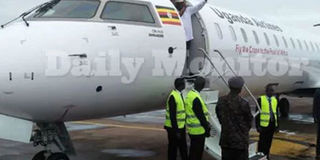Uganda Airlines managers must avoid past mistakes

Uganda yesterday received two Bombardier CRJ900 planes as it revives the defunct Uganda Airlines.
The black-yellow-red double-striped tail planes, however, won’t lift up for a commercial flight until July, at the earliest. Each of the 76-seater plane cost $28m (Shs103b).
Their touchdown at Entebbe International Airport yesterday was met with great delight. Traditional entertainers thrilled guests with a well-choreographed performance. The pilots and crew stepped down the gangway to wild acclaim.
There was the customary water salute where two facing fire tenders blast an arc of water across a plane to mark its first landing at an aerodrome. President Museveni flew in by helicopter from upcountry to preside over the launch of the revival of the national carrier. The hard work, which will shape the growth or collapse of the national airline, now must start.
We from the onset welcome the government’s decision to revive the national career. However, we remain alive to the millstones that abound.
The huge investment must be justified beyond national pride. The government must pursue clear strategies for converting this airline into profitable venture in spite of the turbulent and loss-making regional and continental airline business.
This requires managers superintending the revived national airline to learn from, and avoid mistakes, that took down the predecessor outfit: Undercapitalisation, mismanagement, political interference and stripping of its assets.
Former president Idi Amin set up the Uganda Airlines Corporation, the parent company for Uganda Airlines, through a May 17, 1976 decree.
The current government liquidated it in 2001, and privatised the ground handling services at Entebbe Airport, the guaranteed cash cow for any national carrier. This contract for this service must be revised to revert it to the revived Uganda Airlines as it prospects new passenger revenue streams from businesspeople, tourists and Ugandan Diaspora. It is our position that requisite technical procedures for securing air operator certificate must be expedited.
Already the government has proclaimed that its priority regional destinations include Nairobi, Kigali, Juba and Johannesburg before expanding to the Democratic Republic of Congo and West Africa nations.
Resolution of these routes, and partnerships with other airlines, must be fast-tracked for actual commercial flights to start ahead of the December 2020/January 2021 delivery of the two 257-seater airbus planes for inter-continental flights. LaMine Sanogo, an aviation analysts, in an article published in the April 20, 2019 Saturday Monitor edition, offers priceless counsel for Uganda Airlines’ success.
These include training and professionalism of staff; safety and security; branding; customer loyalty programme; guaranteed high payload; monetising data; and, pricing attractiveness.




